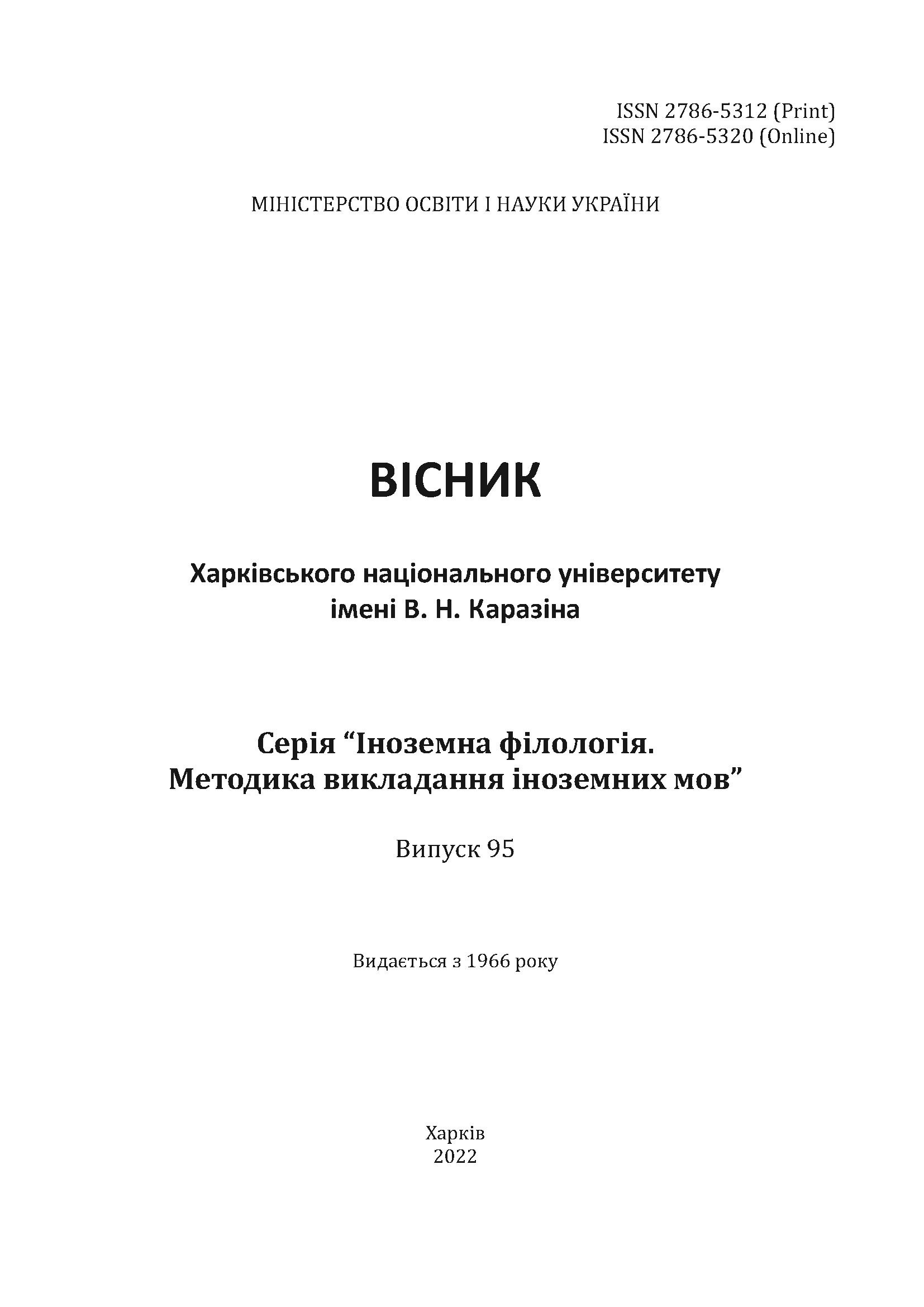Teaching mindfulness to ELL students as a social-emotional learning wartime coping strategy: a multimodality perspective
Abstract
This article focuses on exploring the pressing issue of teaching armed conflict affected English language learning (ELL) Ukrainian students to be mindful to better cope with wartime stressors for the sake of their psychological, physical health, intellectual and emotional well-being, enhanced resilience and ethical sustainability. Within the methodological framework of social emotional learning and linguocognitive paradigms, the authors have substantiated the status of the time-tested practice of mindfulness as a coping tool kit to be integrated in teaching English to students in conflict settings. As a result of the study conducted, it has been concluded that consistent practices of teaching mindfulness to students who suffer from war (post)-traumatic stress disorders, depression, anxiety, lack of hope, fear, have promising linguodidactic and psychological implications that result in students’ language performance improvements. On the basis of analytically summarizing methods to implement (non-)verbally represented mindfulness as a coping mechanism in the corresponding EFL environment, the authors have come up with a four-dimensional mindfulness developing model of multimodal coping strategies for war affected ELL students. The matrix model suggested includes problem-focused, emotion-focused, avoidance and faith-based linguodidactic activities with an emphasis on the multimodal nature of mindfulness. The most efficient exercises are presented in the paper. It has been pointed out that mindfulness can be taught through listening, speaking, writing, reading practices, as well as through stimulating verbally and non-verbally actualized visual, auditory, olfactory, haptic, and gustatory types of perception, The pilot research project carried out, whose outcomes are to be perspectively refined, interculturally enriched and amalgamated into a coursebook, has proved that helping ELL students with wartime experience to be more mindful through adaptive coping strategies can mediate and moderate the negative impact of armed conflict trauma on their mental health and well-being.
Downloads
References
Bastos, F. (2022). Mindfulness five senses: how to use your senses to get out of your mind. MindOwl. Retrieved from https://mindowl.org/mindfulness-5-senses/
Brito, J. (2022). 1-minute mindfulness exercises. Retrieved from https://psychcentral.com/health/minute-mindfulness-exercises.
Bürgin, D., Anagnostopoulos, D., & the Board and Policy Division of ESCAP. et al. (2022). Impact of war and forced displacement on children’s mental health – multilevel, needs-oriented, and trauma-informed approaches. Eur Child Adolesc Psychiatry. Retrieved from https://doi.org/10.1007/s00787-022-01974-z
Downes, S., Lynch, A., & O’Loughlin, K. (2015). Introduction. War as Emotion: Cultural Fields of Conflict and Feeling. In S. Downes, A. Lynch, & K. O’Loughlin (Eds.), Emotions and War (pp. 1–23). London: Palgrave Macmillan. https://doi. org/10.1057/9781137374073_1
Eldemir Tuyan, S., Badayi, B. (2019). Cultivating mindfulness in an EFL classroom. An exploratory study. Empowering Teacher- Researchers, Empowering Learners, 67–78.
Fei, V. L., Weimin, T., & Nguyen, T. (2022). Multimodality in the English language classroom: A systematic review of literature. Linguistics and Education, 69. https://www.sciencedirect.com/science/article/abs/pii/S0898589822000365
Gavrilovic, J., Lecic-Tosevski, D.,·Dimic, S.,·Pejovic-Milovancevic, M., Knezevic, G., & Priebe, S. (2003). Coping strategies in civilians during air attacks. Soc Psychiatry Psychiatr Epidemiol, 38, 128–133, https://www.researchgate.net/publication/10874952_Coping_strategies_in_civilians//_during_air_attacks
Hanh, T. N. (2009). Happiness. Parallax Press: New York, NJ.
Isserman, N., Hollander-Goldfein, B., & Nechama-Horwitz, S. (2013). In their own words: Survivor wartime and late life coping styles. Wartime experience and late life coping, 3. http://kavod.claimscon.org/2013/02/wartime-coping/
Kleber, R., Brom, D., & Defares, P. (2003). Coping with trauma. Boca Raton, FL: CPC Press.
Kocovski, N., & Fleming, J. (2009). Mindfulness and acceptance-based group therapy for social anxiety disorder: an open trail. Cognitive and behavioral practice, 16, 276–289.
Krippner, S., & McIntyre, M. (2019). The psychological impact of war trauma on civilians: an international perspective (psychological dimensions to war and peace). Westport, CT: Praeger.
Krishnan, H. Mindfulness as a strategy for sustainable competitive advantage. Business Horizons, 64, Issue 5, 697–709. https://doi.org/10.1016/j.bushor.2021.02.023
Lin, Y., Eckerle, W., Peng, L., & Moser, J. (2019). On variation in mindfulness training: A multimodal study of brief open monitoring meditation on error monitoring. Brain Sci., 9. https://www.ncbi.nlm.nih.gov/pmc/articles/PMC6770246/
Martin, M. (2020). Analyzing conceptual metaphors of emotion in mindfulness literature (Dissertation). Universitat Jaume.
Mellese, J. (2022). The war in Ukraine can have devastating long-term consequences on the mental health of children and young people. MHE Digest. Retrieved from https://www.mhe-sme.org/ukraine-crisis-mental-health-impact-young-people/
Scott, E. (2020). What is mindfulness? VerywellMind. Retrieved from https://www.verywellmind.com/mindfulness-meditation-88369 17.
Sickel, E. (2017). Why can’t I feel? Dissociation and emotional detachment in response to trauma. Restored hope counselling service. Retrieved from https://www.restoredhopecounselingservices.com/blog/2017/10/4/why-cant-i-feel 18.
Solomon, Z. (1995). Coping with War-Induced Stress: The Gulf War and the Israeli Response. New York, NY: Springer.
Stephens, K. (2018). Strategies to help children cope with fear and anxiety during wartime. Patenting and caregiving exchange. Retrieved from https://www.easternflorida.edu/community-resources/child-development-centers/parent-resource-library/documents/coping-with-fear-wartime.pdf
Walton, I. (2020). Daily mindfulness for students: six activities. Teacher zone. Retrieved from https://teacherblog.ef.com/daily-mindfulness-for-students-6-activities/
Whalen, Ch. (2022). How social emotional learning can help facilitate safe and productive conversations about difficult topics: The Ukraine/Russia conflict. Rethink Ed. Social Emotional Learning. Retrieved from https://www.rethinked.com/blog/2022/03/21/how-social-emotional-learning-can-help-facilitate-safe-and-productive-conversations-about-difficult-topics-the-ukraine-russia-conflict/productive-conversations-about-difficult-topics-the-ukraine-russia-conflict/




